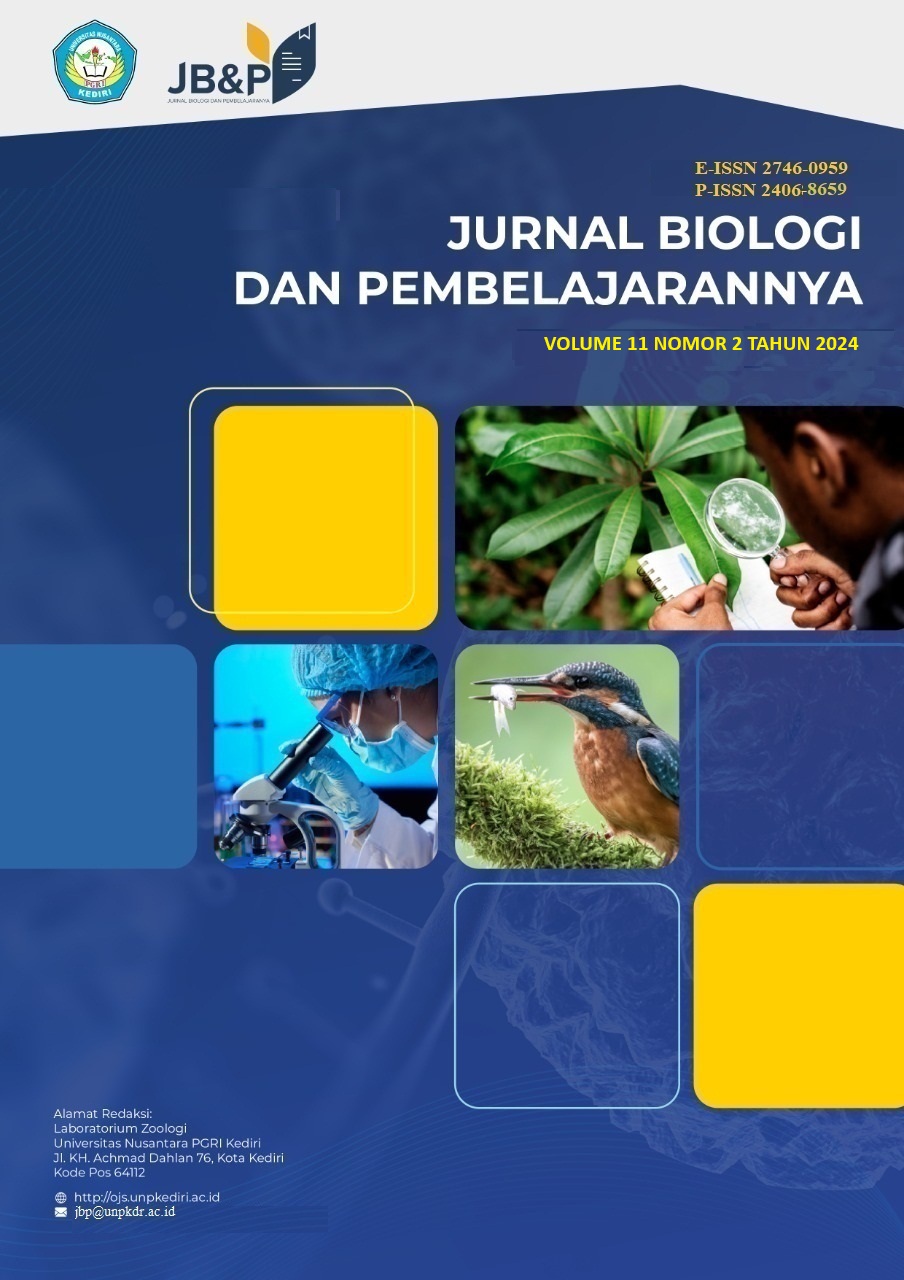Isolasi dan Identifikasi Bakteri Fiksasi Nitrogen Dari Akar Padi Hidroponik Dan Akar Padi Konvensional
DOI:
https://doi.org/10.29407/jbp.v11i2.22304Keywords:
Bacteria, Isolation, Identification, Oryza sativaAbstract
Nitrogen fixation bacteria are bacteriathat are able to convert free nitrogen into nitrogen that can be used by theplants. This study aims to determine the presence of bacteria fixationnitrogen fixation bacteria in hydroponic and conventional rice roots and can identify the bacteriaidentify the bacteria. Isolation was done from the roots of rice (Oryza sativa) with the scatter blot method on NA (Nutriet Agar), and then tested for thethen tested for the ability to fix nitrogen using mineral-free nitrogen media added with Brontomimineral-free nitrogen medium added with Brontomiul Blue and glucose, which was incubated for 24 hours, thenincubated for 24 hours and then biochemical tests. From the results of the isolation there are 2 isolates that are able to bind nitrogen and have the ability ofHOS 833 ppm and KOS 1,128 ppm. The results of the characteristics and biochemistrycharacteristics and biochemistry showed that the isolate HOS is the genusBacillus genus and KOS is Azotobacter genus.
References
Amiruddin, R. R., Darniati, D., & Ismail, I. (2017). Isolasi dan Identifikasi Salmonella sp pada Ayam Bakar di Rumah Makan Kecamatan Syiah Kuala Kota Banda Aceh. Jurnal Ilmiah Mahasiswa Veteriner, 1(3), 265-274.
Antralina, M., Kania, D., & Santoso, J. (2015). Pengaruh pupuk hayati terhadap kelimpahan bakteri penambat nitrogen dan pertumbuhan tanaman kina ( Cinchona ledgeriana Moens ) klon Cib . 5. Jurnal Penelitian Teh Dan Kina, 18(2), 177–185.
Asrul, A., & Pugeg Aryantha, I. N. (2021). Isolasi Dan Identifikasi Bakteri Penambat Nitrogen Untuk Pembuatan Biofertilizer. VIABEL: Jurnal Ilmiah Ilmu. Ilmu Pertanian, 15(1), 16-23.
Fallo, G., Buak, A., & Pardosi, L. (2022). Seleksi Seleksi Dan Identifikasi Bakteri Penambat Nitrogen Pada Perakaran Tanaman Kacang Hijau (Vigna Radiata L) Dan Tomat (Solanum Lycopersicum L) Di Kabupaten Belu. Jurnal Biologi Dan Pembelajarannya (Jb&P), 9(1), 34-41.
Hartati, H., Azmin, N., Nasir, M., Bakhtiar, B., & Nehru, N. (2020). Penggunaan Media Tanam Hidroponik Terhadap Produktivitas Pertumbuhan Tanaman Terong (Solanum melongena). ORYZA (Jurnal Pendidikan Biologi), 9(2), 14-20.
Ilangumaran, G., & Smith, D. L. (2017). Plant Growth Promoting Rhizobacteria in Amelioration of Salinity Stress: A Systems Biology Perspective. Frontiers in plant science, 8, 1768. https://doi.org/10.3389/fpls.2017.01768
Irfan, M. (2014). Isolasi dan enumerasi bakteri tanah gambut di perkebunan kelapa sawit PT. Tambang Hijau Kecamatan Tambang Kabupaten Kampar. Jurnal Agroteknologi, 5(1), 1-8.
Ismail, Y. S., Yulvizar, C., & Putriani, P. (2017). Isolasi, karakterisasi dan uji aktivitas antimikroba bakteri asam laktat dari fermentasi biji kakao (Theobroma cacao L.). Jurnal Bioleuser, 1(2).
Istiqomah, N., & Ramdhani, A. H. (2018). Profil Vitamin C Mangga Podang di Kecamatan Mojo, Semen, Banyakan dan Tarokan Kabupaten Kediri. Jurnal Biologi & Pembelajarannya, 5(1), 24-31.
Kondororik, federika. (2016). Identifikasi Komposisi Pigmen, Isolasi, dan Aktivitas Antioksidan β Karoten pada Rumput Laut Merah Gracilaria gigas Hasil Budidaya. Jurnal Biologi Dan Pembelajarannya (JB&P), 3(1). https://doi.org/10.29407/jbp.v3i1.443)
Moningka, C. N. G., Ludong, D. P. ., & Rumambi, D. P. (2020). Kajian Irigasi Mikro Pada Sistem Hidroponik Padi ( Oryza sativa L .) Varietas Serayu Dalam Rumah Tanaman. Jurnal Teknologi Pertanian, 11(1).
Sari, R., & Prayudyaningsih, R. (2015). Rhizobium: pemanfaatannya sebagai bakteri penambat nitrogen. Buletin Eboni, 12(1), 51-64.
Umarie, I., Hazmi, M., & Muhaimin, M. (2019). Respons Tanaman Padi ( Oryza Sativa L. ) Terhadap Berbagai Media Tanam Dan Sumber Nutrisi Pada Sistem Tanam Hidroponik Vertikultur Bokas. Agritop, 17(1), 21–34.
Downloads
Published
Issue
Section
License
Authors who publish with this journal agree to the following terms:
- Copyright on any article is retained by the author(s).
- The author grants the journal, right of first publication with the work simultaneously licensed under a Creative Commons Attribution License that allows others to share the work with an acknowledgment of the work’s authorship and initial publication in this journal.
- Authors are able to enter into separate, additional contractual arrangements for the non-exclusive distribution of the journal’s published version of the work (e.g., post it to an institutional repository or publish it in a book), with an acknowledgment of its initial publication in this journal.
- Authors are permitted and encouraged to post their work online (e.g., in institutional repositories or on their website) prior to and during the submission process, as it can lead to productive exchanges, as well as earlier and greater citation of published work.
- The article and any associated published material is distributed under the Creative Commons Attribution-ShareAlike 4.0 International License













